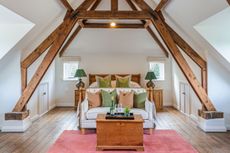Devon: officially England’s best county
Country Life reveals Devon as England’s best county


Who could be surprised—except the inhabitants of Cornwall—that Devon has been awarded the Best County crown? Every county has its special qualities, which speak to the heart of the people who know them. Northumberland’s wild, empty beaches, Herefordshire’s orchards, the round flint towers of Norfolk churches, the intimacy of Kent… As for Yorkshire, it is a kingdom, if not a universe, unto itself. But few England’s best county Adam Burton counties can match the variety that Devon manages to pack into its 2,589 square miles. It is the only county to have two separate coastlines. Nowhere else, as Alec Clifton-Taylor comments in the introduction to Devon’s ‘Buildings of England’ volume, has ‘such a variety of building materials’. Being the third-largest county gives it something of an advantage, admittedly, over minnows such as Rutland.
Once, as we know from the peerage, Devon had ‘shire’ tacked onto its name. The shire was an Anglo-Saxon unit of administration, and although scholars may debate whether shires are co-terminus with counties (an area ruled by a medieval count or lord), our familiarity with the county structure has embedded it in our psyche. At a time when other forms of identity are breaking down, people remain intensely loyal to the counties in which they live, whether or not they were born there. The size is right. Parachute into Devon—or any county—from outer space and look around you, and you’ll know exactly where you are. You couldn’t be anywhere else.
Devon, geographers say, is the most consistently hilly of counties. It also rains, and thank goodness: the shaggy hedgerows and rich, sweet pasture zing with sap. The sight of cows in this dairy paradise makes one’s knife hand itch to be folding clotted cream on top of a scone. Hills mean valleys, deep and wooded, which can only have been formed by a benign providence for one purpose (bang, bang—does that give you a clue?). And valleys mean brawling salmon rivers.
Visitors to the Devon and Somerset Staghounds think they could ride over the open moorland forever—and might well do so, if they don’t have the strength to pull up. You can take Devon warm, sitting around a log fire drinking scrumpy, or take it wild, as Sherlock Holmes discovered when he camped out on Dartmoor, investigating a certain hound. You won’t be the first to holiday or retire here.Fishing villages such as Dawlish put down their nets in the 18th century, and have been hauling in a catch of tourists ever since. In the Regency, Devon became a conspicuous breeding ground for the cottage ornée.
There aren’t many grand country houses, to be sure. During the Civil War, Devon came out for Parliament: one of the many bones it is stick-picking with royalist Cornwall. Instead, Devon’s signature building type is the long house, perhaps built of cob or rammed earth, where the farmer shared the same roof as his animals. The Saxon towns include Modbury, proud to be the first community in Europe to eschew plastic bags. It was probably also the first to insist that the electricity board left a redundant junction box in place, because it was just the right height for leaning your elbow on when having a chat, or ‘yar’ as they say in these parts. That’s Devon. Don’t hurry, and why change?
*Read Country Life's explanation on how we calculated the best county in England 2009
Sign up for the Country Life Newsletter
Exquisite houses, the beauty of Nature, and how to get the most from your life, straight to your inbox.
Country Life is unlike any other magazine: the only glossy weekly on the newsstand and the only magazine that has been guest-edited by HRH The King not once, but twice. It is a celebration of modern rural life and all its diverse joys and pleasures — that was first published in Queen Victoria's Diamond Jubilee year. Our eclectic mixture of witty and informative content — from the most up-to-date property news and commentary and a coveted glimpse inside some of the UK's best houses and gardens, to gardening, the arts and interior design, written by experts in their field — still cannot be found in print or online, anywhere else.
-
 What's the name for a baby hedgehog? Country Life Quiz of the Day
What's the name for a baby hedgehog? Country Life Quiz of the Day10 questions to test your memory, nous and instinct for a wild guess.
By Toby Keel Published
-
 A five-bedroom family home that would host the perfect Henley party
A five-bedroom family home that would host the perfect Henley partyChurch Field in Fawley is spacious and magnificently well appointed, both inside and out.
By James Fisher Published